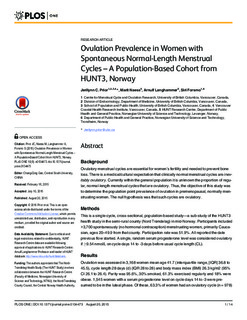Ovulation prevalence in women with spontaneous normal-length menstrual cycles - A population-based cohort from HUNT3, Norway
Journal article
Permanent lenke
http://hdl.handle.net/11250/2373592Utgivelsesdato
2015Metadata
Vis full innførselSamlinger
Sammendrag
Background:
Ovulatory menstrual cycles are essential for women’s fertility and needed to prevent bone loss. There is a medical/cultural expectation that clinically normal menstrual cycles are inevitably ovulatory. Currently within the general population it is unknown the proportion of regular, normal-length menstrual cycles that are ovulatory. Thus, the objective of this study was to determine the population point prevalence of ovulation in premenopausal, normally menstruating women. The null hypothesis was that such cycles are ovulatory.
Methods:
This is a single-cycle, cross-sectional, population-based study—a sub-study of the HUNT3 health study in the semi-rural county (Nord Trøndelag) in mid-Norway. Participants included >3,700 spontaneously (no hormonal contraception) menstruating women, primarily Caucasian, ages 20–49.9 from that county. Participation rate was 51.9%. All reported the date previous flow started. A single, random serum progesterone level was considered ovulatory if ≥9.54 nmol/L on cycle days 14 to -3 days before usual cycle length (CL).
Results:
Ovulation was assessed in 3,168 women mean age 41.7 (interquartile range, [IQR] 36.8 to 45.5), cycle length 28 days (d) (IQR 28 to 28) and body mass index (BMI) 26.3 kg/m2 (95% CI 26.1 to 26.4). Parity was 95.6%, 30% smoked, 61.3% exercised regularly and 18% were obese. 1,545 women with a serum progesterone level on cycle days 14 to -3 were presumed to be in the luteal phase. Of these, 63.3% of women had an ovulatory cycle (n = 978) and 37% (n = 567) were anovulatory. Women with/ without ovulation did not differ in age, BMI, cycle day, menarche age, cigarette use, physical activity, % obesity or self-reported health. There were minimal differences in parity (96.7% vs. 94.5%, P = 0.04) and major differences in progesterone level (24.5 vs. 3.8 nmol/L, P = 0.001).
Conclusion:
Anovulation in a random population occurs in over a third of clinically normal menstrual cycles.
